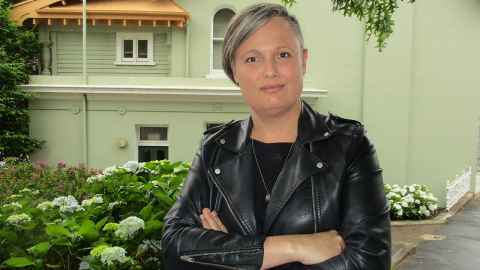Advocating for intersex human rights: Meet Sarah Bickerton

Research fellow Dr Sarah Bickerton, 46, grew up as a boy and transitioned to a woman, but knew she didn’t identify as transgender, only finding out as an adult, through her own reading, she was intersex.
On global Human Rights Day 10 December, Sarah and the Equity Office Te Ara Tautika, would like to highlight human rights issues for people born with a variation in sex characteristics, including surgeries and hormonal treatments performed on babies and children.
“I would love to see less surgery on infants and children and more funded surgery available for older teenagers and adults, when they have had time to make an informed choice, rather than doctors fitting children into some idea of the way ‘normal’ genitals are supposed to look,” Sarah says.
Globally, it is estimated 1.7 percent of the population are intersex, around the same proportion who have red hair.
A recent report on Rainbow human rights from the Human Rights Commission, called Prism (June 2020) finds intersex people are likely to be discriminated against at work. But, the main human rights issue identified in the report is medical interventions. Read Prism.
“The limited data available show that medical and surgical (cosmetic, i.e., not necessary for the preservation of life) interventions continue to take place on infants and children in Aotearoa before an age at which they can freely give fully informed consent,” Human Rights Commission advisor Taine Polkinghorne says.
New Zealand also requires identification of male or female gender on birth certificates, when Rainbow youth, including those with variations in sex characteristics, may develop into their gender identity over time.
After growing up as a boy, Sarah discovered she was different at puberty.
“My voice didn’t drop, my Adam’s apple didn’t form. I didn’t get a big and bulky masculine body. I looked androgynous. And I also didn’t mature. If you see a photo of me when I was 19, I look 13.”
Sarah went to the library to try to figure out why she felt like she was "a chick".
I did what any nerd would do, I went to the library and did research. But all that I could find in the early 90s was on trans and it was very medicalised and pathologised.
Sarah didn’t identify with descriptions of transgender people, which were back then often as very “femme” while she was developing into a leather jacket and boots-style lesbian. But it was all she could find.
When her mother discovered she had been researching transgender topics, the atmosphere was so tense Sarah took the opportunity to finish school in the Netherlands, where she had family.
On her return to study at the University of Canterbury, she effectively came out a second time. Her parents sent her to a psychiatrist, who noted she was “possibly intersex” but didn’t share that information with her, as Sarah discovered when she requested her notes years later.
Her parents gave her an ultimatum to stop doing what she was doing or be disowned. So, for many years, Sarah was not part of her family.
Not long afterwards, Sarah was referred for hormone treatment, got her name changed legally and transitioned to identifying as a lesbian woman.
She wanted to have surgery, but, at that time (the 1990s), it wasn’t funded and, as a student, she couldn’t afford it.
Sarah had to support herself through undergraduate degrees in Science and Arts (Sociology major), then progressing first-class honours and on a Master of Arts (Sociology) with first-class distinction.
Sarah got accepted into a doctoral programme in the US and moved to the University of Illinois at Chicago, where she got to the point known in the States as “all but dissertation”.
While she was in Chicago, Sarah had started researching herself again and came across a diagnosis of “partial androgen insensitivity syndrome (PAIS) - a condition where cells respond poorly to androgens (male hormones).
“I went through the symptoms and thought ‘That’s me, that’s totally me,’” Sarah says.
Sarah saw specialists who confirmed the diagnosis. PAIS is one of at least 40 variations that fall under the umbrella of “intersex”.
In 2009 her father died, having started to reach out to reconcile with Sarah over her gender identity . Sarah felt burnt out from studying and lecturing and was questioning her future in academia.
At the end of that year, Sarah returned to New Zealand and has subsequently reconciled with her mother.
After a number of years in the workforce, Sarah returned to Victoria University to complete her doctorate, then took up a position in early 2020 at the University of Auckland as a postdoctoral research fellow in the Public Policy Institute.
She is on a waiting list for funded surgery, likely to take place in 2021.
Rainbow Network co-chair Dr Terry O’Neill appreciates Sarah’s willingness to tell her story and build awareness in the University community.“For too long intersex issues, and experiences, have not received the attention and support they deserve,” Terry says.
All queer staff and students are encouraged to join the Equity Office's Rainbow Network.
As an early career researcher, Sarah has limited time to lend to activism, but she is keen to work with the Equity Office in raising visibility of the intersex community.